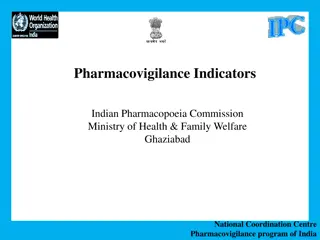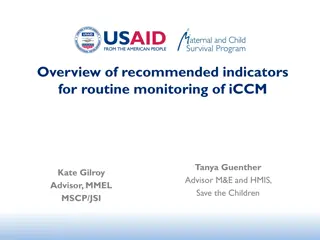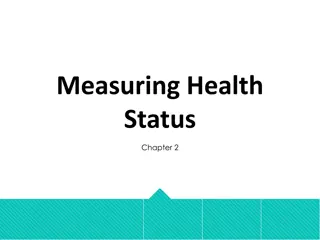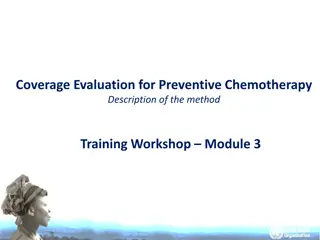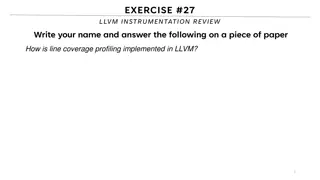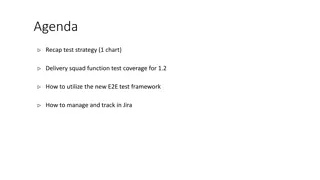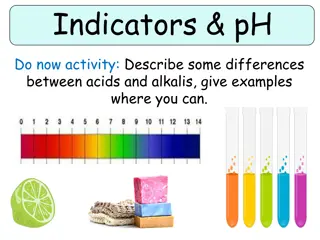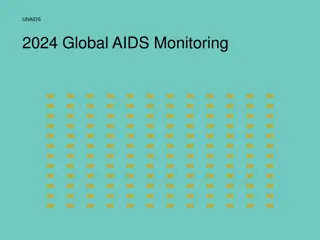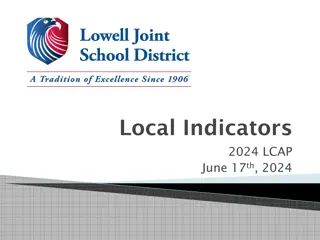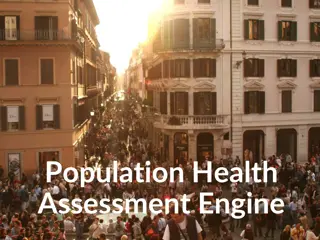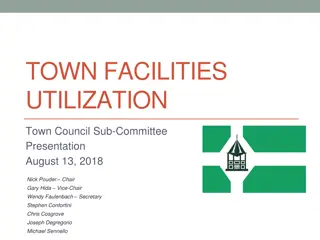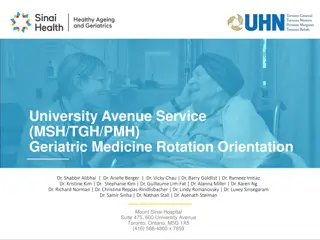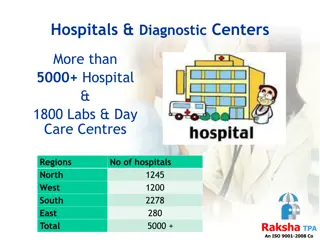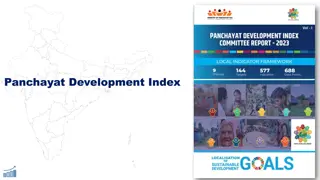Comprehensive Assessment of Denominators for Population Coverage and Service Utilization Indicators
This document outlines the importance of denominators in determining the percentage of the population reached by healthcare services. It covers a range of indicators for both preventive and curative services, providing insights on population projections, target populations, and specific interventions. The analysis includes indicators like outpatient visits, inpatient admissions, preventive interventions for pregnant women and infants, curative interventions for children under 5, mortality rates, and family planning coverage.
Download Presentation

Please find below an Image/Link to download the presentation.
The content on the website is provided AS IS for your information and personal use only. It may not be sold, licensed, or shared on other websites without obtaining consent from the author. Download presentation by click this link. If you encounter any issues during the download, it is possible that the publisher has removed the file from their server.
E N D
Presentation Transcript
#4a Denominators for coverage and service utilization indicators
Objectives Objectives Produce a comprehensive assessment of the denominators for the computation of population coverage and service utilization from health facility data which includes analysis of the population projection data in the DHIS2 assessment of the total (live) births projections with reported numbers of events for high coverage interventions analysis of selected coverage rates at national and subnational level using the standard projections in DHIS2 For: National Province/region (District) Decide on denominators for the analyses of population indicators
Why denominators? Why denominators? We want to know what percent of the population is reached by the health services, based on the number of events (ANC visits, deliveries, immunizations, treatments etc.) Therefore, we have to define the population in need of a specific service; also referred to as the target population Health service utilization indicators Preventive services indicators: Curative services indicators e.g., ANC visits, institutional deliveries, immunization (e.g. child with malaria, diarrhoea, pneumonia) e.g., Outpatient services, Inpatient admissions Denominator: Denominator: Children who are sick and need treatment population with specific age and sex, derived from population projection Denominator: Total population (under 5, 5+)
Indicators and denominators Indicators and denominators Indicators Numerator Denominator SERVICE UTILIZATION Outpatient visits, children under 5, per year (N) N of OPD visits for under-5 Total mid-year population under 5 Inpatient admissions, children under 5, per year (N) N of admissions for under-5 Total mid-year population under 5 PREVENTIVE INTERVENTIONS % of pregnant women with 4 antenatal care visits N of women with ANC 4th visit Total N of pregnant women in the whole population % of live births in health facilities N of live births in health facilities Total N of live births in the whole population % of infants receiving 3 doses of pentavalent vaccine N of infants receiving 3 doses N of infants eligible for 3 doses of the vaccine CURATIVE INTERVENTIONS % of children under 5 with malaria who receive ACT N of children U5 with malaria receiving ACT Total N of children who had malaria in the last year % of deliveries that were by C-section (population) N of C-sections reported Total N of deliveries in the population % of deliveries that were by C-section (institutional) N of C-sections reported Total N of deliveries in health facilities MORTALITY % of births that were stillbirths N of stillbirths in health facilities Total N of births in health facilities FAMILY PLANNING Ratio FP visits to women of reproductive age N of FP new and revisits Total N of women 15-49 years Estimated modern use of contraceptives Couple years of protection Total N of women 15-49 years FP coverage (demand satisfied) N of women using modern methods Total N of women in need of FP
Population versus institutional indicators Population versus institutional indicators Example of C Example of C- -section section Data for a hypothetical region Institutional delivery coverage = 10,000 / 20,000 * 100 = 50% 1000 C-sections (from DHIS2 reports for one year) Institutional rate of C-sections = 1,000 / 10,000 * 100 = 10% 10,000 deliveries in health facilities (from DHIS2 reports for one year) Population rate of C-sections = 1,000 / 20,000 * 100 = 5% 20,000 deliveries in the whole population (from population projections) Notes: C-section rate is not a coverage indicator as the population in need is not known C-section rate is often expressed per 1,000 live births, not deliveries
Census population projections to obtain denominators National population census is the main source for population by age and sex for the country and subnational areas Denominators for health service-based statistics are derived from census population projections These projections have errors Population census was not accurate (and is hotly debated) Projection assumptions about fertility, mortality, and migration were not correct Deviations from the true situation are more likely the longer ago the population census was conducted 6
Year of the last census: all 22 countries Last 5 years 2017-2021 Cote d'Ivoire Ghana Sierra Leone Burkina Faso Kenya Malawi Mozambique Last 10 years 2012-2016 Uganda Senegal Niger Rwanda Tanzania Zimbabwe More than 10 yrs ago Before 2012 Zambia Chad Guinea Mali Liberia Ethiopia Nigeria Cameroon DR Congo 2021 2021 2020 2019 2019 2018 2017 2014 2013 2012 2012 2012 2012 2010 2009 2009 2009 2008 2007 2006 2005 1984
Assessment of the population projections: five steps Assessment of the population projections: five steps Compile the population projection indicators (from DHIS2): Total population, Population groups (<1, <5, F 15-49), Live births 1 Compute demographic parameters by year: population growth rate, percentages in the age/sex groups, Crude Birth Rate, Crude Death Rate 2 Evaluate the demographic parameters: a) consistency over time b) comparison with UN Population projections 3) survey results on crude birth rates 3 Compute coverage rates for the highest coverage interventions by year: first ANC visit (ANC1) and first dose of DPT (DPT1) and graph these with the total number of live births 4 Summarize and interpret the findings of the assessment in a brief document: for national and provincial/regional level 5
Compile the population projection indicators (from DHIS2): Total population, Population groups (<1, <5, F 15-49), Live births 1 The data are part of country data set excel version; by region/province and national A Stata version of the population data should be available as an output of running Stata Code #1 of the data quality assessment analyses Produce a data set with the national and region/province totals for the indicators (STATA and Excel templates available)
Compute demographic parameters by year: 2 population growth rate, percentages in the age/sex groups, Crude Birth Rate, Crude Death Rate (national, regions) STATA code and Excel spreadsheet analysis tools compute the demographic parameters Population growth (r ) = ln (P2 / P1) / (t2 t1) * 100% Crude Birth Rate (CBR) = N of live births / Total Population * 1000 Note Stillbirths are generally not included Crude Death Rate (CDR) = N of deaths / Total Population * 1000 CDR = CBR population growth rate (per 1,000), if there is no net in- or out- migration
Evaluate the demographic parameters: a) consistency over time b) comparison with UN Population projections 3) survey results on crude birth rates (national, selected regions) 3 Consistency over time: large changes between years are improbable UN Population projections: can be obtained from SOURCE Survey results on crude birth rates: use the most recent survey, can be obtained from Stat Compiler; or survey reports
Compute coverage rates for the highest coverage interventions by year: first ANC visit (ANC1) and first dose of DPT (DPT1) and graph these with the total number of live births (national, selected regions) 4 Select the highest coverage indicators from the national surveys DHS, MICS): usually ANC1 and DPT1 (BCG can also be added as indicator) Step 4A: Graph the number of ANC1 visits and DPT1 vaccinations (BCG) by year, obtained from the clean final DHIS2 data file; and the number of live births from the population projections (line graph) Step 4B: Compute coverage of ANC1 and DPT1 (BCG), based on the DHIS2 numbers and the population projections
4B: For ANC1 visit coverage: we need to estimate the number of 4B: For ANC1 visit coverage: we need to estimate the number of pregnancies from the projected live births pregnancies from the projected live births The number of live births in DHIS2 [e.g. 1,000] Add the stillbirth (default stillbirth rate= 0.02) to obtain total births: 1000/(1- 0.02) =1020 Use the twinning rate to estimate the number of deliveries (default 0.015) [1020 / (1+0.015) = 1005] Add pregnancy loss between 4-6 months (after average ANC1 visit, default 0.03) to obtain the number of pregnancies [1005 / (1 0.03) = 1036] ANC1 coverage: N of ANC1 visits / total estimated pregnancies * 100%
4B: For DPT1/BCG coverage, we need to estimate the number of 4B: For DPT1/BCG coverage, we need to estimate the number of eligible infants from the live births projection in DHIS2 eligible infants from the live births projection in DHIS2 The number of live births in DHIS2 [e.g., 1,000] Subtract those who have died before they reach the eligible age for the vaccination (DPT1, recommended 6 weeks, BCG, recommended at birth): neonatal mortality rate (default 0.03) [1,000 0.03* 1000 = 970]
4A + 4B: Compute and graph the coverage of ANC1 and DPT1 4A + 4B: Compute and graph the coverage of ANC1 and DPT1 (BCG), using the DHIS2 denominators (BCG), using the DHIS2 denominators ANC1 = N of ANC1 visits in DHIS2 / N of pregnancies computed from live birth projections * 100% DPT1 = N of DPT1 vaccinations / N of infants eligible for vaccination computed rom live birth projections * 100% National and by (selected) regions / provinces
Summarize and interpret the findings of the assessment in a brief document: for national and provincial/regional level 5 A short report for the final report and poster board
Country work STATA codes 4_Code_RHIS_DenominatorAssessment- FINAL.do Produces log file, Excel outputs and graphs for national and subnational levels Make sure to indicate your working folder Specify your country Change default values as relevant For the graphs, you may need to modify the labels to adapt to your specific country Excel workbook 4. Denominators & Coverage Analysis.xls Template based on Niger data There are data sheets and analysis sheets with graphs The analysis sheets include formulas that need to be adapted to your country Hint: use find and replace to adapt the formula to your country Modify default values as relevant









